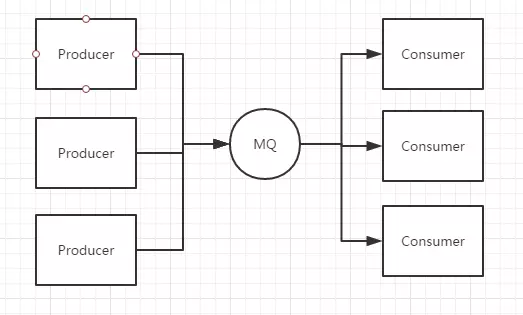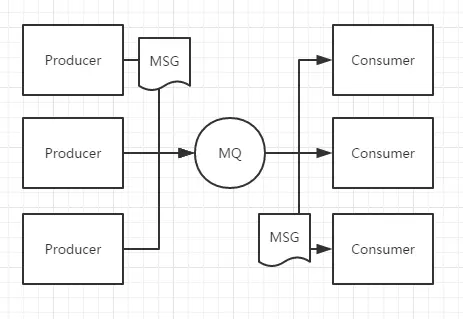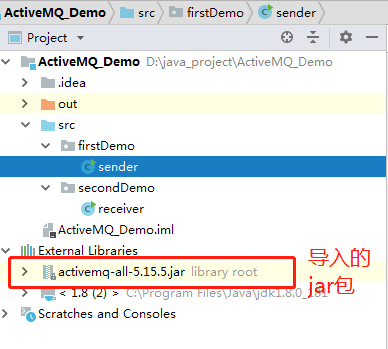ActiveMQ的学习整理(代码实现PTP,以及Pub/Sub)
(一)由于在实习过程中需要用到ActiveMQ,在网上看了很多文章,现在整理出来以防忘记。
(二)这篇文章比较适合之前没有接触过的同学,在看下面文章的过程中,建议先学习参考链接中的知识点,然后自己再参考我的代码来实现实现PTP,以及Pub/Sub,两遍下来基本能搞定ActiveMQ的基础知识。
(三)参考链接:https://www.jianshu.com/p/b547db55d168
这是关于消息中间件ActiveMQ的一个系列专题文章,将涵盖JMS、ActiveMQ的初步入门及API详细使用、两种经典的消息模式(PTP and Pub/Sub)、与Spring整合、ActiveMQ集群、监控与配置优化等。
JMS
首先来说较早以前,也就是没有JMS的那个时候,很多应用系统存在一些缺陷:
1.通信的同步性:client端发起调用后,必须等待server处理完成并返回结果后才能继续执行;
2.client 和 server 的生命周期耦合太高:client进程和server服务进程都必须可用,如果server出现问题或者网络故障,那么client端会收到异常;
3.点对点通信:client端的一次调用只能发送给某一个单独的服务对象,无法一对多;

需要注意的是,JMS只是定义了Java访问消息中间件的接口,其实就是在包javax.jms中,你会发现这个包下除了异常定义,其他都是interface。我们可以扫一眼,比如Message:

JMS只给出接口,然后由具体的中间件去实现,比如ActiveMQ就是实现了JMS的一种Provider,还有阿里巴巴的RocketMQ(后续专题中在为大家介绍)。这些消息中间件都符合JMS规范。说起规范,自然要定义一些术语:
Provider/MessageProvider:生产者
Consumer/MessageConsumer:消费者
PTP:Point To Point,点对点通信消息模型
Pub/Sub:Publish/Subscribe,发布订阅消息模型
Queue:队列,目标类型之一,和PTP结合
Topic:主题,目标类型之一,和Pub/Sub结合
ConnectionFactory:连接工厂,JMS用它创建连接
Connnection:JMS Client到JMS Provider的连接
Destination:消息目的地,由Session创建
Session:会话,由Connection创建,实质上就是发送、接受消息的一个线程,因此生产者、消费者都是Session创建的
PTP模式实现

PTP模式特点:
1,每个消息只有一个消费者(Consumer)(即一旦被消费,消息就不再在消息队列中)
2,发送者和接收者之间在时间上没有依赖性,也就是说当发送者发送了消息之后,不管接收者有没有正在运行,它不会影响到消息被发送到队列
3,接收者在成功接收消息之后需向队列应答成功
(一)在IntelliJ IDEA中新建project,然后再建立两个项目,以及相应的类

(二)启动ActiveMQ
双击apache-activemq-5.5.1\bin\activemq.bat运行ActiveMQ程序。启动ActiveMQ以后,登陆:http://localhost:8161/admin/(默认账号密码为admin),创建一个Queue,命名为FirstQueue。
详细过程参考:https://www.cnblogs.com/xwdreamer/archive/2012/02/21/2360818.html
(三)sender与receiver的代码
sender:

1 import org.apache.activemq.ActiveMQConnection; 2 import org.apache.activemq.ActiveMQConnectionFactory; 3 4 import javax.jms.*; 5 import java.util.Date; 6 7 public class sender { 8 private static final int SEND_NUMBER = 5; 9 10 public static void main(String[] args) { 11 // ConnectionFactory :连接工厂,JMS 用它创建连接 12 ConnectionFactory connectionFactory; 13 // Connection :JMS 客户端到JMS Provider 的连接 14 Connection connection = null; 15 // Session: 一个发送或接收消息的线程 16 Session session; 17 // Destination :消息的目的地;消息发送给谁. 18 Destination destination; 19 // MessageProducer:消息发送者 20 MessageProducer producer; 21 22 // TextMessage message; 23 // 构造ConnectionFactory实例对象,此处采用ActiveMq的实现jar 24 connectionFactory = new ActiveMQConnectionFactory(ActiveMQConnection.DEFAULT_USER, ActiveMQConnection.DEFAULT_PASSWORD,"tcp://localhost:61616"); 25 try { 26 // 构造从工厂得到连接对象 27 connection = connectionFactory.createConnection(); 28 // 启动 29 connection.start(); 30 // 获取操作连接 31 session = connection.createSession(Boolean.TRUE, Session.AUTO_ACKNOWLEDGE); 32 // 获取session注意参数值xingbo.xu-queue是一个服务器的queue,须在在ActiveMq的console配置 33 destination = session.createQueue("FirstQueue"); 34 // 得到消息生成者【发送者】 35 producer = session.createProducer(destination); 36 // 设置不持久化,此处学习,实际根据项目决定 37 producer.setDeliveryMode(DeliveryMode.NON_PERSISTENT); 38 // 构造消息,此处写死,项目就是参数,或者方法获取 39 sendMessage(session, producer); 40 session.commit(); 41 } catch (Exception e) { 42 e.printStackTrace(); 43 } finally { 44 try { 45 if (null != connection) { 46 connection.close(); 47 } 48 } catch (Throwable ignore) { 49 } 50 } 51 } 52 53 public static void sendMessage(Session session, MessageProducer producer) throws Exception { 54 for (int i = 1; i <= SEND_NUMBER; i++) { 55 Date date = new Date(); 56 TextMessage message = session.createTextMessage(date + " ActiveMQ 发送的消息:" + i); 57 // 发送消息到目的地方 58 System.out.println("发送消息: " + date + " ActiveMQ 发送的消息 " + i); 59 producer.send(message); 60 } 61 } 62 }
receiver:

import org.apache.activemq.*; import javax.jms.*; public class receiver { public static void main(String[] args) { // ConnectionFactory :连接工厂,JMS 用它创建连接 ConnectionFactory connectionFactory; // Connection :JMS 客户端到JMS Provider 的连接 Connection connection = null; // Session: 一个发送或接收消息的线程 Session session; // Destination :消息的目的地;消息发送给谁. Destination destination; // 消费者,消息接收者 MessageConsumer consumer; connectionFactory = new ActiveMQConnectionFactory(ActiveMQConnection.DEFAULT_USER, ActiveMQConnection.DEFAULT_PASSWORD, "tcp://localhost:61616"); try { // 构造从工厂得到连接对象 connection = connectionFactory.createConnection(); // 启动 connection.start(); // 获取操作连接 session = connection.createSession(Boolean.FALSE, Session.AUTO_ACKNOWLEDGE); // 获取session注意参数值xingbo.xu-queue是一个服务器的queue,须在在ActiveMq的console配置 destination = session.createQueue("FirstQueue"); consumer = session.createConsumer(destination); while (true) { //设置接收者接收消息的时间,为了便于测试,这里谁定为100s TextMessage message = (TextMessage) consumer.receive(100000); if (null != message) { System.out.println("收到消息:" + message.getText()); } else { break; } } } catch (Exception e) { e.printStackTrace(); } finally { try { if (null != connection){ connection.close(); } } catch (Throwable ignore) { } } } }
(四)调试效果


Pub/Sub模式

Pub/Sub模式特点
1,每个消息可以有多个消费者
2,发布者和订阅者之间有时间上的依赖性。针对某个主题(Topic)的订阅者,它必须创建一个订阅者之后,才能消费发布者的消息,而且为了消费消息,订阅者必须保持运行的状态。
3,为了缓和这样严格的时间相关性,JMS允许订阅者创建一个可持久化的订阅。这样,即使订阅者没有被激活(运行),它也能接收到发布者的消息。
(一)新建项目

(二)show the code
TopicProducer:

1 package pub_sub; 2 3 import org.apache.activemq.*; 4 import javax.jms.*; 5 import java.util.Date; 6 7 public class TopicProducer { 8 private static final int SEND_NUMBER = 5; 9 public static void main(String[] args) { 10 // ConnectionFactory :连接工厂,JMS 用它创建连接 11 ConnectionFactory connectionFactory; 12 // Connection :JMS 客户端到JMS Provider 的连接 13 Connection connection = null; 14 // Session: 一个发送或接收消息的线程 15 Session session; 16 // Destination :消息的目的地;消息发送给谁. 17 Destination destination; 18 // MessageProducer:消息发送者 19 MessageProducer producer; 20 // TextMessage message; 21 // 构造ConnectionFactory实例对象,此处采用ActiveMq的实现jar 22 connectionFactory = new ActiveMQConnectionFactory(ActiveMQConnection.DEFAULT_USER, ActiveMQConnection.DEFAULT_PASSWORD,"tcp://localhost:61616"); 23 24 try { 25 // 构造从工厂得到连接对象 26 connection = connectionFactory.createConnection(); 27 // 启动 28 connection.start(); 29 // 获取操作连接 30 session = connection.createSession(Boolean.TRUE, Session.AUTO_ACKNOWLEDGE); 31 32 // 获取session注意参数值是一个服务器的Topic,须在在ActiveMq的console配置 33 destination = session.createTopic("FirstTopic"); 34 producer = session.createProducer(destination); 35 // 设置不持久化,此处学习,实际根据项目决定 36 producer.setDeliveryMode(DeliveryMode.NON_PERSISTENT); 37 // 构造消息,此处写死,项目就是参数,或者方法获取 38 sendMessage(session, producer); 39 session.commit(); 40 41 } catch (Exception e) { 42 e.printStackTrace(); 43 } 44 finally { 45 try { 46 if (null != connection) { 47 connection.close(); 48 } 49 } catch (Throwable ignore) { 50 } 51 } 52 } 53 54 public static void sendMessage(Session session, MessageProducer producer) throws Exception { 55 for (int i = 1; i <= SEND_NUMBER; i++) { 56 Date date = new Date(); 57 TextMessage message = session.createTextMessage(date + " ActiveMQ 发送的消息:" + i); 58 // 发送消息到目的地方 59 System.out.println("发送消息: " + date + " ActiveMQ 发送的消息 " + i); 60 producer.send(message); 61 } 62 } 63 }
TopicConsumer:

1 package receiver; 2 3 import org.apache.activemq.*; 4 import javax.jms.*; 5 6 public class TopicConsumer{ 7 8 public static void main(String[] args) { 9 // ConnectionFactory :连接工厂,JMS 用它创建连接 10 ConnectionFactory connectionFactory; 11 // Connection :JMS 客户端到JMS Provider 的连接 12 Connection connection = null; 13 // Session: 一个发送或接收消息的线程 14 Session session; 15 // Destination :消息的目的地;消息发送给谁. 16 Destination destination; 17 // 消费者,消息接收者 18 MessageConsumer consumer; 19 connectionFactory = new ActiveMQConnectionFactory(ActiveMQConnection.DEFAULT_USER, ActiveMQConnection.DEFAULT_PASSWORD, "tcp://localhost:61616"); 20 21 try { 22 // 构造从工厂得到连接对象 23 connection = connectionFactory.createConnection(); 24 // 启动 25 connection.start(); 26 // 获取操作连接 27 session = connection.createSession(Boolean.FALSE, Session.AUTO_ACKNOWLEDGE); 28 // 获取session注意参数值是一个服务器的Topic,须在在ActiveMq的console配置 29 destination = session.createTopic("FirstTopic"); 30 consumer = session.createConsumer(destination); 31 // while (true) { 32 // //设置接收者接收消息的时间,为了便于测试,这里谁定为100s 33 // TextMessage message = (TextMessage) consumer.receive(100000); 34 // if (null != message) { 35 // System.out.println("收到消息:" + message.getText()); 36 // } else { 37 // break; 38 // } 39 // } 40 while(true){ 41 consumer.setMessageListener(new listern()); 42 } 43 } catch (Exception e) { 44 e.printStackTrace(); 45 } 46 finally { 47 try { 48 if (null != connection){ 49 connection.close(); 50 } 51 } catch (JMSException e) { 52 e.printStackTrace(); 53 } 54 } 55 } 56 }
listern:

1 package receiver; 2 3 import javax.jms.JMSException; 4 import javax.jms.Message; 5 import javax.jms.MessageListener; 6 import javax.jms.TextMessage; 7 8 public class listern implements MessageListener { 9 @Override 10 public void onMessage(Message message) { 11 try { 12 System.out.println("收到的消息:"+((TextMessage)message).getText()); 13 } catch (JMSException e) { 14 // TODO Auto-generated catch block 15 e.printStackTrace(); 16 } 17 } 18 }
(三)注意事项
1. 运行代码的时候要先运行订阅者代码,然后运行发布者代码。
2. Consumer中注释代码为不添加Listern的实现。







